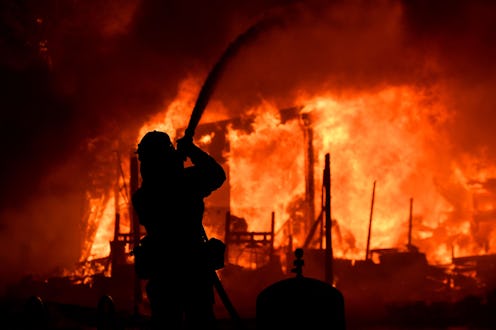News
Female Inmates In California Are Paid Only $1 Per Hour To Fight Raging Wildfires

As the wildfires in California continue to tear across the northern part of the state, all available hands have been on deck to fight the blazes. Over 8,000 firefighters were mobilized by Thursday, according to Cal Fire, but they weren't the only group at the ready. Approximately 200 female inmates fight fires in California as part of an ongoing fire camp program, and they do so for only $1 an hour.
“It's really slave labor," candidate for Lieutenant Governor Gayle McLaughlin says in an interview with Bustle. "It’s saying, 'Hey, we’ll give you a dollar an hour' as if that’s anything at all."
By Thursday, Oct. 12, the fires had reportedly killed at least 29 people. Sonoma County Sheriff Robert Giordano said it would be "unrealistic" to not expect more fire-related deaths, per The Los Angeles Times.
The female inmates who help fight the fires are part of a "Conservation Camp" program run by the California Department of Corrections and Rehabilitation. According to the CDCR website, the mission of the camp program is "to provide an able-bodied, trained work force for fire suppression and other emergencies such as floods and earthquakes." The crews also "work on conservation projects on public lands and provide labor on local community services projects."
According to CDCR, there are 43 adult camps and one for juveniles, which combined can house just over 4,600 firefighters. Currently, there are about 3,000 adult inmate firefighters, 200 of which are female. Three camps house female inmates. Combined, NBC reported that the inmate firefighters make up 13 percent of the state's overall firefighting force. And, according to CDCR, the inmate program is purported to save taxpayers approximately $100 million.
All inmate firefighters, regardless of gender, are expected to meet the same training requirements.
"All of our crews are specifically trained to cut fire breaks that stop or slow the spread of the fire," CDCR spokesperson Bill Sessa said in an email to Bustle. "They work in teams of 14 most of the time, working ahead of the fire with hand tools."
As of Oct. 13, female crews were fighting fires just north of the San Francisco Bay area, and some are fighting the the Canyon 2 fire in Anaheim. Others providing back-up fire protection in their local areas to compensate for those who have been moved to other areas up north.
The annual operating budget per camp is approximately $2.35 million, according to the CDCR's website. But NBC reported that each firefighter in the camps is paid $2 per day, and $1 an hour for time spent in front of fire. A spokesperson for CDCR told Bustle that the camp positions pay inmates more than any other prison job.
McLaughlin, who served two terms the mayor of Richmond, California, described the program as "heavy exploitation and slave labor."
The camp program isn't considered vocational training, which means that it's not designed to help participants become full-time firefighters upon release.
"Some of them may — and some of them may not — want to go into the vocation of fire fighting when they are released from prison, and they should have that option," McLaughlin said. She explained that she would support the program if it paid a decent wage — at least $15 an hour, she said — and provided vocational training. "To pay them a dollar an hour, putting their lives on the line — that really struck me as so exploitative," she said.
Bill Sessa told Bustle in that most inmates don't aspire to be firefighters after they're done with the program. But, he said, their motivations for volunteering make sense if you consider the program from the perspective of the inmates, rather than from outside the prison system.
"The camps are a different and more welcoming environment than a prison, the food is better and they are the highest paying job a prison inmate can have," Sessa explained. "Most also will tell you that they appreciate the opportunity to do something constructive during their time in prison and perhaps pay back the community for the crime they committed."
The camp program has existed, in some form, since 1915. The first permanent location, the Rainbow Conservation Camp, was opened in 1946. It then converted to a female camp in 1983, according to the CDCR.
In a separate video interview with NBC, inmate Sandra Walsh said that she could be on-call for up to seven days a week, and that she could be called out at any time of day. She said she has been "at camp" for sixteen months.
In February 2016, The Los Angeles Times reported that the program suffered its first female fatality, a 22-year-old inmate named Shawna Lynn Jones. Jones reportedly died because a boulder fell 100 feet and hit her on the head. According to the report, Jones was the third person to die in the conservation camp program since it officially began in 1943.
Inmates must volunteer to participate in the conservation camp program, but not all inmates are eligible. They must demonstrate a reputation of good behavior, submit to screening, and be physically fit to serve. They must be "minimum-custody" and cannot be convicted of sexual assault, arson, or have "any history of escape with force or violence." If accepted, Cal Fire trains the recruits both in a classroom and in the field, according to the CDCR.
"I'm just looking to say that everyone has human rights — if you’re in prison, if you’re not in prison — and this seems to violate [them]," McLaughlin said.